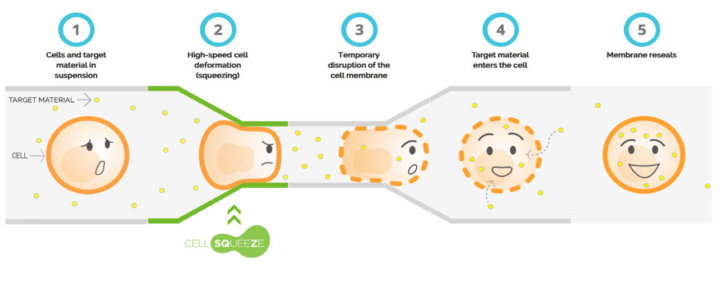Cell Squeeze® is a commercial technology designed to manipulate individual cells (ie. a patient’s own cells) through mild perturbation that leaves the cells viable after mechanoporation – or the insertion of a cargo directly into a cell’s cytosol. SQZ Biotech is the sole developer of this technology.
One early application consists of a microchip that gently forces antigen-presenting cells (APCs) to pass through a narrow channel in a microfluidic device. Pressure temporarily disrupts the cell membrane and creates pores in the cell wall that allow external substances—including whole proteins and potentially tumor lysates—to penetrate the cells. Cell Squeeze® causes fewer gene expression changes than electroporation.

Immune cells are the company’s initial targets. For example delivering anti-HIV siRNAs for blocking HIV infection in CD4+ T cells; and whole protein antigen and enabling MHC class I processing/presentation in polyclonal B cells, facilitating B cell-based vaccine approaches.
Surfactants (e.g. , 0.1-10% w/w) are optionally used (e.g., poloxamer, animal derived serum, albumin protein) in the flow buffer to speed up the process. Delivery of molecules into cells is not affected by the presence of surfactants; however, surfactants are optionally used to reduce clogging of the device during operation. The company suggests scaling the throughput is indicated at more than ten billion units per minute.
RELATED: A Serendipitous Discovery Is At The Heart Of SQZ Biotech
To date, the company has leveraged Cell Squeeze® to build three cell therapy platforms that it is applying to multiple therapeutic areas. These platforms are designed to modulate the immune system in a target-specific manner with initial applications in oncology, infectious disease and immune disorders. The company’s platforms are designed to be able to manufacture product candidates in under 24 hours and administered without any pre-conditioning and without any planned hospitalization, creating what the company believe is a more streamlined, accessible patient experience and a lower burden on the health system, from a time and cost perspective.
Gene Editing
Cell Squeeze® could solve the problem of intracellular delivery of gene editing components and gene editing complexes to target cells. SQZ beleives the delivery of gene editing components, e.g., protein, ribonucleic acid (RNA), and deoxyribonucleic acid (DNA), by mechanical disruption of cell membranes improves gene editing. Because intracellular delivery of gene editing materials is a current challenge, its technology provides a mechanism to engineer target cells without the use of potentially harmful viral vectors or electric fields. The scalability and relative simplicity of the process make it suitable for broad adoption. The strategy and methods are suitable for genome engineering applications in research and therapeutics.
I have not witnessed the company’s CEO, Dr. Sharei, wade too deep into the limp theater of saucy TAM porn. Instead, the company’s potential is easy enough to surmise given a little knowledge about the limitations of current cell therapies that have been afflicted with the subvirus of failure. I’ve seen this quality before in other early-stage companies where serendipity tempers expectations and moderates the evil forces of bravado. It is possible that Dr. Sharei and SQZ Biotech have opened up a new frontier of space – the intracellular space – mediated by this company’s novel membrane-disruption-based techniques.
<<Do natural voltage gradients in cells (not just neurons) regulate cell behavior and gene expression in ways that undermine electroporation? One way to think about the interworkings of a living being is to look at each cell membrane as a computational surface that interacts with its surroundings (ie. other cells and perturbations) to orchestrate homeostasis. Existing cell therapies, including electrical, chemical and viral agents, miss the mark because of incompatibility with the computational surface. To wit: maybe it was always about the hardware.>>
On the frontier of this new technique is a powerful yet largely untapped tool for decoding and engineering cell function1 including the systematic delivery of protein biologics into living cells, such as active inhibitory antibodies and stimulatory transcription factors. Measurement of intracellular chemical and physical properties with innovative devices, sensors and probes is another frontier. Probes engineered from functional nanomaterials—including nanoplasmonic optical switches, carbon nanotubes and quantum dots—have generated excitement in research communities for decades but ineffective intracellular delivery, a poor understanding of their interaction with biological environments, and toxicity issues have retarded their deployment in the cellular context. These delivery challenges are particularly acute in the case of important patient-derived cell types such as immune cells, stem cells and neurons. <<In vivo control of cell collectives?>>
- Stewart, Martin P.; Sharei, Armon; Ding, Xiaoyun et al. “In Vitro
and Ex Vivo Strategies for Intracellular Delivery.” Nature 538, 7624
(October 2016): 183–192 © 2016 Macmillan Publishers Limited, part
of Springer Nature
The ideas presented on this site do not constitute a recommendation to buy or sell any security. Investors are advised to conduct their own independent research into individual stocks before making a purchase decision. In addition, investors are advised that past stock performance is not indicative of future price action. You should be aware of the risks involved in stock investing, and you use the material contained herein at your own risk. Neither SYNTHETIC.COM nor any of its contributors are responsible for any errors or omissions which may have occurred. The analysis, ratings, and/or recommendations made on this site do not provide, imply, or otherwise constitute a guarantee of performance. SYNTHETIC.COM posts may contain financial reports and economic analysis that embody a unique view of trends and opportunities. Accuracy and completeness cannot be guaranteed. Investors should be aware of the risks involved in stock investments and the possibility of financial loss. It should not be assumed that future results will be profitable or will equal past performance, real, indicated or implied. The material on this website is provided for information purpose only. SYNTHETIC.COM does not accept liability for your use of the website. The website is provided on an “as is” and “as available” basis, without any representations, recommendations, warranties or conditions of any kind.

